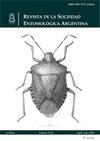Efficacy of phototrophic bacterial feed supplementation on economic traits and disease resistance in mulberry silkworm, Bombyx mori (Lepidoptera: Bombycidae)
IF 0.5
4区 农林科学
Q4 ENTOMOLOGY
引用次数: 1
Abstract
Sericulture, often known as silk farming is the practice of rearing silkworms for production of raw silk. One of the major impediments faced by the sericulture community is the silkworm diseases that cause significant crop losses. In the present study, the efficacy of phototrophic bacteria as feed supplements in improving the economic traits as well as disease resistance in mulberry silkworm, Bombyx mori L. was assessed. A total of three phototrophic bacteria were isolated and identified as belonging to the genera Marichromatium, Rhodobacter and Rhodopseudomonas based on 16S rRNA gene sequencing analysis. Their morphological, physiological and biochemical characters were studied, grown under ambient conditions and biomass was harvested. Mulberry fortified with the aforementioned phototrophic bacteria in solitude and combinations at varying concentrations (0.5, 1, 2 and 5%) were found to be innocuous to the mulberry silkworm. The best results were observed when mulberry leaf was supplemented with Rhodopseudomonas sp. at 2% concentration which improved survival, cocoon weight, shell weight, shell%, filament length and non-breakable filament length by 5.18, 0.27, 3.86, 3.5, 1.5 and 1.2%, respectively under normal rearing conditions. Under Staphylococcus sp. infected conditions, the aforesaid diet also enhanced survival in silkworms by 16%. On the other hand, the same diet didn’t exhibit any discernible influence on survival against fungal, viral, or microsporidian infections in silkworm.光养细菌饲料对桑蚕经济性状和抗病性的影响(鳞翅目:家蚕科)
蚕业,通常被称为养蚕,是一种养蚕生产生丝的做法。蚕桑界面临的主要障碍之一是蚕病,这些疾病会造成严重的作物损失。本研究评价了光营养细菌作为饲料添加剂对桑蚕经济性状和抗病性的改善作用。根据16S rRNA基因测序分析,共分离出3种光营养细菌,分别属于海洋染色单体属、红细菌属和红假单胞菌属。研究了它们的形态、生理和生化特性,在环境条件下生长并收获了生物量。用上述光营养细菌单独和不同浓度(0.5%、1%、2%和5%)组合强化的桑蚕对桑蚕无害。在正常饲养条件下,添加2%浓度的红假单胞菌对桑叶的成活率、茧重、壳重、壳%、纤丝长度和不断丝长度分别提高了5.18%、0.27、3.86、3.5、1.5和1.2%。在葡萄球菌感染的条件下,上述饮食也使蚕的存活率提高了16%。另一方面,相同的饮食对家蚕抵抗真菌、病毒或微孢子虫感染的存活没有任何明显的影响。
本文章由计算机程序翻译,如有差异,请以英文原文为准。
求助全文
约1分钟内获得全文
求助全文
来源期刊

Revista De La Sociedad Entomologica Argentina
Agricultural and Biological Sciences-Insect Science
CiteScore
0.80
自引率
20.00%
发文量
31
审稿时长
20 weeks
 求助内容:
求助内容: 应助结果提醒方式:
应助结果提醒方式:


